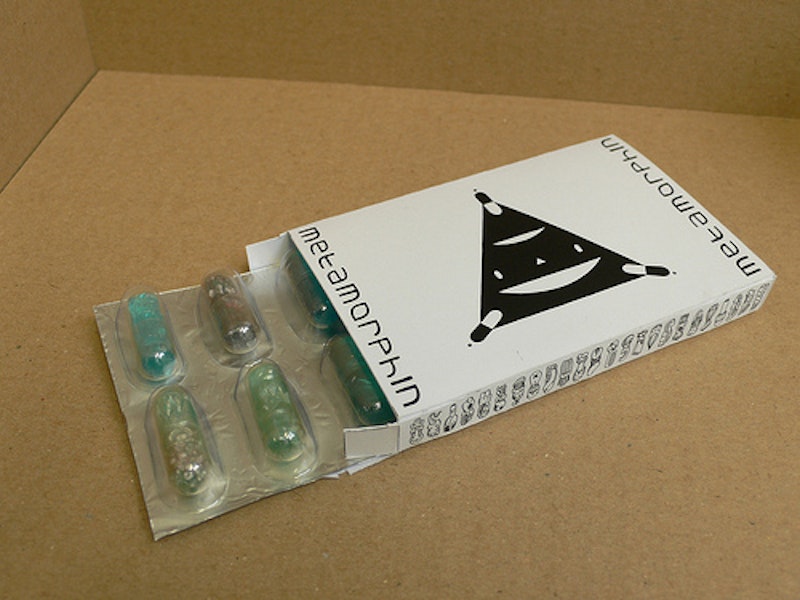While a fair portion of the independent art-toy design world slowly shifts towards a bleak homogenization, Daniel Goffin is one of the artists who stands out. As a stunningly kinetic illustrator, Goffin shuns symmetry and order for a miasma of action and alien, techno-biological forms. This almost abstracted approach to aesthetics is something that he has translated with surprising success to a series of resin figurines which depict some of the chracters from his narrative series of Netzwerk illustrations, which focus on the collision between man, machine, medicine and interconnectedness.
As an intellectual extension of these ideas, Goffin recently began creating very small sculptures, around the size of a traditional gel caplet. In fact, they fit inside caplets, are made of a completely edible material called isomalt, and will shortly be made available on blister packs under the title "Metamorphin." While tiny sculpture has a tradition dating back hundreds of years, tiny edible sculpture distributed in pill form has to be a first. While Goffin doesn't actually suggest that you eat his cast isomalt sculptures, the possibility does certainly exist, and that implied interactivity, and even unity, between the artwork and observer, proposes a lot of interesting possibilities for the definition of art.
SPLICE TODAY: Where did the idea of edible sculpture come from?
DANIEL GOFFIN: I love doing things by and with my hands (sculpting, casting and all that) and so that's something where learning is rather easy for me. The idea for working with isomalt was inspired by the artwork one of my fellow fine art students did for her graduation. We had a meeting while setting up the group show of our graduation projects and she complained about how expensive the base material for her sculptures was. And while she went on explaining I thought that this isomalt sugar really was a lot less expensive than the resin I was working with. But to cut a long story short, I needed a small yet simple shape to test the material and somehow I came up with a pill. This happened to spawn a chain reaction of associations that led to what is now called Metamorphin.
ST: Have you tested how long these pieces will actually last, or is the slow decay part of the appeal?
DG: I have been asked this already quite a lot but I must admit that I have not tested how long these pieces last. Slow decay is surely part of the appeal. All I know is that isomalt is a lot less sensitive to humidity than sugar. Then, these sculptures are contained in a gelatine capsule and above all that they're sealed within an airtight plastic blister. That should make them hold up for a bit. Of course you can still unwrap them and eat them like any hard candy. They're sweet - that's the one thing I have tested. Still, I am an artist and no candy maker so these are really not meant for consumption.
ST: How are these being distributed?
DG: The first run of 20 sets, a blue-turquoise colorway, will be sold exclusively at my duo-show (together with Martin Osuna) at LA's Toy Art Gallery. So, if anyone is interested I can only recommend signing up for the preview list at their website. Or even better, come to show's opening and meet me there in person! There will be more releases in the future in different colors and those will be available in my online store.
ST: What are your future creative plans in this vein?
DG: I don't really know. Isomalt was right up my alley because it involved sculpting, molding and casting. There is one thing that though that really appeals to me. It is not so much the material itself but rather that I managed to combine my own storytelling not only with weird toy-like sculptures but also with something very iconic that captures the essence of much of our daily lives. If you don't know what I'm getting at just have a look into your spam folder and search for the word 'pill'.
As for future plans... I'd love to find a company to produce these or something similar in jelly. Like gummi bears but just critters of my own design. I'm sure that not only adults would enjoy eating sweet monsters.
ST: Favorite part of the creative process?
DG: That's a good question. The process of creating things, ideas, stories itself is the best thing. The final products may be wonderful to look at but the one thing that keeps me coming back is witnessing things evolve from a simple doodle to a fully painted sculpture/painting/drawing, etc.

